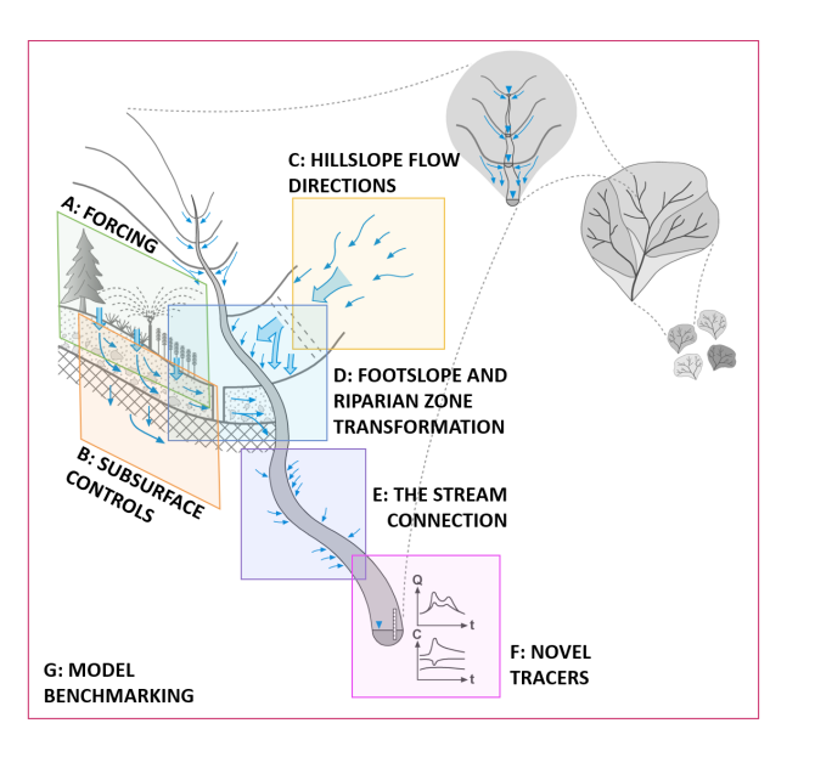F SSF TRACERS- Exploration of biogeochemical tracers (environmental DNA, water soluble organic matter) for tracing subsurface stormflow across spatial and temporal scales [funded by DFG]
Project staff:
Prof. Peter Chifflard
Prof. Dr. Florian Leese
Yvonne Schadewell
Dr. Christina Fasching
Description:

Project F - Novel Tracers aims to explore different biochemical tracers to identify flow pathways and sourceareas of subsurface stormflow.
Inferences of subsurface flow paths, sources and subsurface hydrological connectivity are limited by the various assumptions and sparse direct measurement opportunities. In response to the need for new tracers to detect source areas of subsurface stormflow (SSF), microbial community composition inferred via environmental DNA (eDNA) metabarcoding as well as the spatial differences of optical characteristics of water-soluble organic matter (WSOM; absorbance and fluorescence) in soils offers a so far little considered possibility. Depending on topographic and soil properties, specific habitats for soil microbial and macro-communities are formed, which can be mapped as spatial eDNA patterns and used to precisely locate and regionalize the source areas of SSF. Composition of eDNA is a found to be function of soil organic carbon composition which suggests a close connection of these. The application of artificial tracer DNA offers the possibility to carry out multiple tracer experiments with low technical effort and high information content with respect to subsurface flow paths. However, a rigorous assessment of the applicability of these novel tracers, also in combination, with respect to SSF has not yet been carried out. Thus, we propose to evaluate the potential of eDNA from natural communities as well as artificially applied tracer DNA and optical characteristics of WSOM as non-conservative tracers for SSF and subsurface connectivity in four contrasting catchments in the low and high mountain ranges (Sauerland, Ore Mountains, Black Forest, Alps).
Research Questions
1. Can we use the spatial and vertical distribution of eDNA and WSOM to detect specific source
areas of subsurface stormflow at the point and hillslope scale?
2. How can the combined application of eDNA, WSOM and artifical DNA help to identify vertical
and lateral connectivity of preferential subsurface water flow paths?
3. Can we identify distinct signatures for SSF using classical diversity statistics for eDNA and spectral
characteristics of WSOM to trace subsurface stormflow?
4. What are the environmental restrictions in the different mountainous landscapes represented in this
Research Unit that limit the use of eDNA or WSOM as tracer?
5. Can the composition of WSOM help to explain the microbial composition represented by the eDNA

Methods/Approach
We will carry out soil sampling on 12 hillslopes in these catchments each with 10 soil profiles to detect spatial and dept-related distribution of eDNA and WSOM. In order to investigate the dept-dependent temporal variability of eDNA and WSOM we will take water samples of the subsurface runoff in different soil depths at one trenched hillslope in every catchment during natural rainfall-runoff events. During artificial irrigation experiments at two trenched hillslopes (low and high mountain) the SSF generation and flow paths will be studied in detail using self-designed and applied artificial DNA tracers. To analyze eDNA and WSOM in the lab we will use an array of state-of-the-art laboratory equipment and methods (TOC-Analyzer, Fluorescence Spectrometry, High-throughput amplicon sequencing and quantitative PCR). The use of multivariate statistical techniques (e.g., PCA, CCA, PARAFAC, Clusteranalysis, WGCNA)) will help to identify temporal and spatial patterns to identify source areas of SSF and to detect biochemical signatures of SSF as tracer for SSF.This systematically investigation of eDNA and WSOM at the hillslope scale in contrasting landscape will allow to assess these different biochemical tracers to trace SSF. Moreover, these investigations will create a unique comprehensive database for the derivation of biogeochemical signatures to identify source areas and flow pathways of SSF.
Achievements
- Soil biodiversity differs significantly between different land-use classes and among depth profiles. - These communities can be traced along the hillslope-stream continuum. - Time-series monitoring of eDNA is now possible through the newly developed eDNA passive sampler integrated in the automatic water sampler. - Soil organic matter composition changes significantly over depth profiles with more humic-like, aromatic contributions in the top layers and more protein-like contributions in the deeper - layers. - This pattern also reflected in the SSF outflow from trenches where the soil organic matter export behavior differs between top and bottom trench outflow. - Protein-like components are rapidly depleted during SSF, while humic-like components are increasingly exported.
Publications and poster presentations:
2024 - Schadewell, Y.; Köhler, S.; Chifflard, P. & Leese, F. (2024): Biological connectivity indicates hydrological flow pathways in the subsurface, Issue . . DOI: http://dx.doi.org/10.5194/egusphere-egu24-11740
- URycki, D.R.; Kirtane, A.A.; Aronoff, R.; Avila, C.C.; Blackman, R.C.; Carraro, L.; Evrard, O.; Good, S.P.; Hoyos J., D.C.; López-Rodríguez, N.; Mora, D.; Schadewell, Y.; Schilling, O.S. & Ceperley, N.C. (2024): A new flow path: eDNA connecting hydrology and biology. WIREs Water 11(6), e1749
2021 - Leese, F.; Sander, M.; Buchner, D.; Elbrecht, V.; Haase, P. & Zizka, V.M.A. (2021): Improved freshwater macroinvertebrate detection from environmental DNA through minimized nontarget amplification. Environmental DNA 3(1), 261-276
